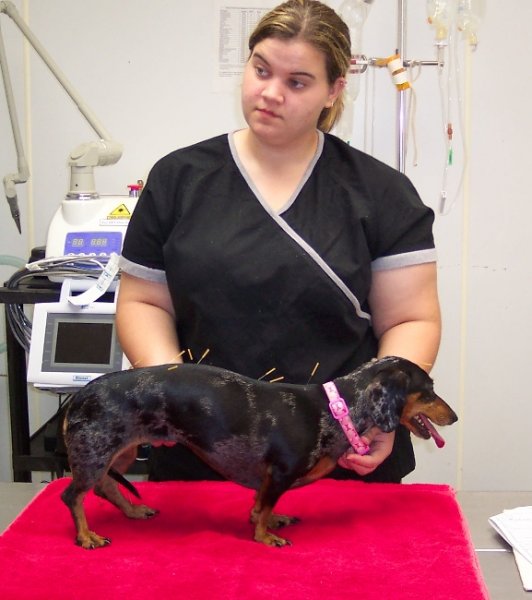(The following Pet Tips were taken from Purdue University's School of Veterinary Medicine's Pet Wellness Clinic.)
ING YOUR PET
While many dogs and cats, as well as other household pets, are always ready and willing to take their oral medications, you may end up discovering that your pet may be quite challenging. Here are several methods that may help alleviate the headache that could arise from an oral prescription for your pet:
1. “Open and insert” is the most basic and simplest method to use if your pet will allow. Simply pull the mouth open and drop the medication on the back of the tongue. Some animals may need their muzzle held shut for a few seconds to ensure swallowing of the rather than spitting it out. 2. Disguising the in a treat may be a valid option if you have an animal that resists working in or around the mouth. Placing in hotdogs, meatballs, and peanut butter are tricks commonly used. Cheese cubes also seem to work very well as the animal is less likely to discover the and work it out. (Be sure to observe the animal eating the entire treat and make sure they don’t walk away while still chewing. Some are very good at spitting the out elsewhere!) 3. Oral suspensions are another option for the animal that refuses to swallow tablets or capsules (if the prescribed drug is available in oral form). Using a syringe or medicine dropper, place the tip underneath the lip on the side of the mouth. It usually works better to quickly squirt in most of the medication and let the animal lick and swallow rather then trying to force in a few drops at a time. Most capsules and tablets may also be dissolved in water and given via syringe, alleviating the need to place one’s hands in an unwilling animal’s mouth. 4. If capsules are being given and the ing method is not agreeing with the animal, the capsule may be opened and the powder within is sprinkled over a treat or mixed in with a small amount of dog food. Make sure to allow the animal to only have access to this small amount of food until all the medication is consumed before feeding the animal the rest of the meal. 5. Over time, your sweet innocent pet may become a master of trickery to combat you in the ongoing battle of ing. Some dogs even get to the point of allowing you in their mouth, placement of medications on the back of the tongue, but still refuse to swallow. A good trick to outwit your pet here is that once the is in the mouth, hold the mouth shut and squirt a small amount of water into the mouth from the side under the lip (same as above using a syringe or dropper). This should stimulate your pet to swallow and the goes down usually unnoticed. Pets and their owners are both evolving new ways to and overcome being ed. It is most important to try different methods with your pet and to administer medications to your animal in the least stressful, simplest, and safest way for both you and your pet.HYPERTHERMIA (HEAT STROKE)
Hyperthermia is defined as an excessively high body temperature of 105-110 ºF. The problem occurs most commonly during the summer when the temperature is high along with a high humidity. It is this Heat Index that is the most important factor for heat stroke. Dogs and cats cannot sweat like people and so they pant to release the heat. The only place a pet can sweat is from their foot pads. Your pet should be provided plenty of shade. It is important to remember that this shade will change throughout the day so a shady spot should be made available at all times. You pet should be provided plenty of fresh water at all times. You should not over exercise your pet on days when the heat index is high. A small child swimming/wading pool filled with fresh water can be used as a cool down source. Your pet should never be left in a car unattended. On a cool day of 75 ºF, the temp. inside a car can soar to 120 ºF in only 10 minutes. Even leaving your windows open does not allow the air to circulate properly to reduce the risk of heat stroke.- Signs of Heat Stoke:
- Excessive panting Excessive Salivation (drooling) Racing pulse Legs, ears, nose hot to the touch +/- vomiting
- What to do if you think you pet is suffering from Heat Stroke?
- Have a pet thermometer to take your pet’s temperature Bring inside to Air Conditioning Place in a cool water bath – offer sips of cool water Contact your regular veterinarian immediately!
WHAT ABOUT CHOCOLATE AND MY DOG?
How many times have you been eating that chocolate chip cookie when you look over and see those sad puppy dog eyes staring at you? You remember hearing that chocolate is toxic to dogs. But what makes chocolate toxic to dogs and why is it that some dogs ingest it and don't get sick? Here are some facts to clear up some of the confusion surrounding chocolate toxicity in dogs. Chocolate can indeed be toxic to dogs. In fact, it is one of the 20 most reported poisonings. The ingredient in chocolate that causes the toxicity is theobromine. The minimum toxic level of theobromine is 100-200mg/kg with 250-500mg/kg being the level at which half of the dogs would die as a result of consuming chocolate. So what does that mean as far as how much chocolate is toxic? The level of theobromine varies depending on the type of chocolate. The levels of theobromine are listed below:| Milk chocolate | 60 mg/oz |
| Baking chocolate | 450 mg/oz |
| Semi-sweet chocolate | 260 mg/oz |
| Hot chocolate | 12 mg/oz |
| White chocolate | 1 mg/oz |
Though it may not be harmful to the dog in small quantities, it is safer to avoid giving chocolate to dogs in general. As with everything else, it's better to be safe than sorry.
Created by Dawn Haas DVM Class of 2003 - PURDUE UNIVERSITY SCHOOL OF MEDICINE





